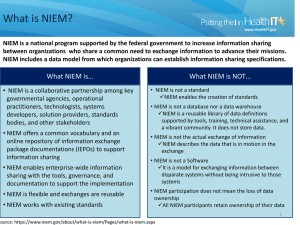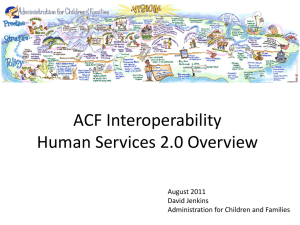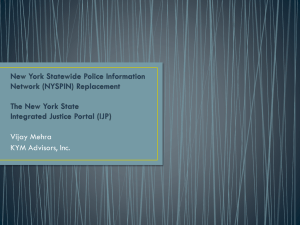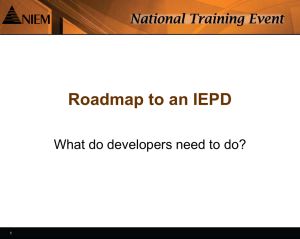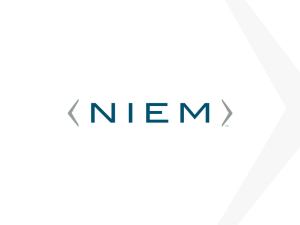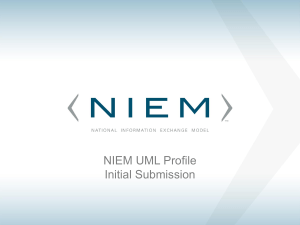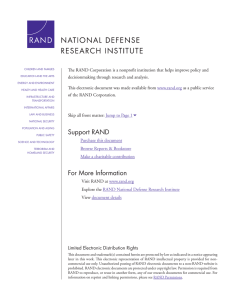2011-10-20_UCoreWayAhead
advertisement
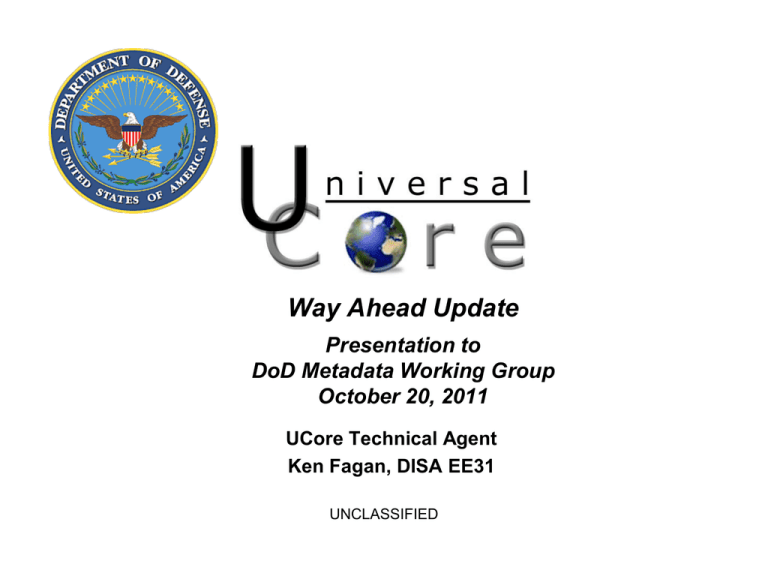
Way Ahead Update Presentation to DoD Metadata Working Group October 20, 2011 UCore Technical Agent Ken Fagan, DISA EE31 UNCLASSIFIED Outline • • • • • Background Requirements Overview of Initial 4 Options Overview of Proposed UCore Way Ahead Summary UNCLASSIFIED 2 Background • UCore Way Ahead Discussions – FEB through OCT 2011 UCore Council meetings • Way Ahead Options Paper: 9 SEP 2011 • Four options were considered as viable ways ahead – Options are not necessarily mutually exclusive, and some details of their execution may overlap • UCore Council Voting – Preliminary : 19 SEP – Follow-on: thru 12 OCT • Discussions with: – – – Program Manager, Information Sharing Environment (PM ISE) National Information Exchange Model Program (NIEM PMO) Intelligence Community (IC CIO) • UCore Council Meeting: 14 OCT – Hybrid Approach presented – Out for vote through 26 OCT UNCLASSIFIED 3 Requirements • The approach should support existing and future requirements for Identity and Access Management (IdAM) and Cross Domain Enterprise Solution (CDES) through resource tagging and attributes derived from UCore interrogatives • The approach should include a technical refresh that aligns UCore with current versions of DDMS/IRM, security tagging, and GEOINT standards • The approach should not preclude the development of a UCore UML profile, or parallel cooperation with the NIEM-UML effort • The approach should position UCore to achieve interoperability with NIEM, with a long-term goal of true convergence UNCLASSIFIED 4 Overview of Initial 4 Options UNCLASSIFIED 5 Overview of Proposed UCore Way Ahead • Phase One: UCore-DDMS Modifications – Perform a tech refresh of schema dependencies – Formalize UCore as a set of extensible, reusable data components (RDCs), including interrogatives, taxonomy, and relationships – Develop “simple” UCore pattern for situational awareness – Extend DDMS to fully support UCore v2.0 Digest content • Phase Two: True NIEM Convergence – Continue cooperation with PM-ISE, NIEM PMO, and IC CIO to resolve issues which prevent DoD/IC from realizing the full benefits of NIEM – Migrate UCore RDCs into NIEM – Engage in pilot activities which model the migration of a DoD project into NIEM UNCLASSIFIED 6 Proposed UCore Way Ahead • Risk Mitigation – DoD CIO will advocate DoD requirements through the NIEM PMO – If NIEM incorporates UCore 3.0 RDCs, UCore adopters will be NIEM compliant – If NIEM does not incorporate UCore 3.0 requirements, UCore will continue to be maintained as a separate specification • Governance Concerns – USMC: Need language for addressing pending UCore/NIEM convergence in requirements – DoD CIO: No standard that competes with the UCore/NIEM Way Ahead should be mandated (e.g., added to DISR) – USAF: No version of UCore or NIEM will be mandated or added to the DISR until it is piloted/tested – DISA/Joint Staff: Should portfolio, COI and program specific initiatives (e.g., C2 Core) be meeting with NIEM or should all requirements be fed through DOD CIO? • Vetting through DoD CIO is appropriate – DOD CIO - How will the DoD vote and provide requirements to NIEM? • DoD CIO will advocate DoD requirements through the NIEM PMO UNCLASSIFIED 7 Diagram of Proposed Way Ahead UNCLASSIFIED 8 Key Activities & Timeline UNCLASSIFIED 9 Summary • We have narrowed down 4 initial options into a hybrid approach that attempts to address the best of each option – 2 phases, parallel path • We are seeking consensus on the hybrid approach – UCore Council voting due 26 OCT 2011 • We are working to partner with appropriate organizations to facilitate secure information sharing across the Federal Government – DoD Components, IC CIO, PM ISE, NIEM PMO For additional details, please see UCore Council site @ https://www.intelink.gov/inteldocs/browse.php?fFolderId=130113 UNCLASSIFIED 10 Backup Slides UNCLASSIFIED 11 Phase 1: Tech Refresh • Update to latest versions of DDMS, ISM.XML, and XLink – Investigate approaches to mitigate security change cycles (OASIS XML Catalog?) – Evaluate suitable integration points for NTK.XML and MAT.XML • Incorporate TSPI 1.0.1/2.0 for Where and When • Additional minor enhancements – Add support for confidence factor – Refresh of taxonomy and relationship model UNCLASSIFIED 12 Phase 1: UCore RDCs • Formalize UCore as a set of extensible reusable data components • Deprecate the ULEX message framework from UCore specification • Develop “simple” pattern for situational awareness – Single Event/Entity per message – Comparable to UCore v1.0 – Compatible with Air Force Cursor-on-Target requirements • Provide supporting direction on RDCs as the foundation for any data exchange, conformance, and valid extension strategies UNCLASSIFIED 13 Phase 1: DDMS Enhancements • DDMS supports all content of UCore v2.0 Digest • Separate an external payload from core content and metadata for greater simplicity and flexibility • Open DDMS Change Requests – Support use of relationship RDCs and UCore extensions – Use TSPI 1.0.1/2.0 for geospatial coverage. • Provide supporting direction on the role of the DDMS metacard – Supports discovery of a more detailed payload when needed – May contain enough actionable information as-is UNCLASSIFIED 14 Phase 1 Result • The UCore “brand” still exists • What is UCore? – UCore is a set of reusable and extensible data components modeling Who, What, Where, and When (and the relationships between them). The RDCs are modeled in a set of schemas, taxonomies, Schematron rules, and extension specifications. – UCore is a GML application schema for situational awareness. – The RDCs are intended to be the foundation of any information exchange or COI vocabulary. • DDMS supports the discovery and location of payloads constructed from applicable RDCs UNCLASSIFIED 15 Phase 2: NIEM Convergence • Continue cooperation with PM-ISE, NIEM PMO, and IC CIO to resolve issues which prevent DoD/IC from realizing the full benefits of NIEM – Address requirements through NIEM NBAC and NTAC • Work towards UCore-NIEM convergence – Determine NIEM location for “core” elements of UCore • Work towards DoD adoption of NIEM – Engage in pilot activities which model the migration of a DoD project into NIEM – Use Geospatial domain as governance test case (follow-up with NGA), understand how NIEM domains are governed, and determine scope of DoD governance – Avoid perception of a divided DoD position UNCLASSIFIED 16 DoD Requirements for NIEM Convergence • Full usage of the GEOINT specifications including GML, NFDD, AIXM, SWE, etc. • Support the need for agile security tagging which accommodates rapid release cycles of Intelligence specifications like ISM, NTK, and MAT – IC CIO is addressing this with NIEM PMO • Alternatives to the Adaptor pattern for referencing external schemas • Support for specifying genuine semantic relationships (subclass and equivalence) and domain restrictions on relationships UNCLASSIFIED 17 Suggested Discussions for NIEM Convergence • The effect of the NIEM NDR when combined with other standards, such as GML and XLink • Inclusion of semantics in the NIEM-UML profile • Support for OWL taxonomies • Looking beyond schema design pattern to webservice interactions when determining future NIEM technical guidance UNCLASSIFIED 18 Phase 2: NIEM Convergence • Evaluation is needed to determine appropriate location for UCore RDCs, either within the NIEM core or a NIEM domain • Resolution of issues and successful pilot activities will provide a better understanding of what largescale DoD NIEM adoption will require • Ultimately, DoD would become a NIEM participant, and address future UCore requirements within the NIEM framework UNCLASSIFIED 19 Phase 2 Result • The UCore “brand” no longer exists • UCore RDCs exist within NIEM as true NIEM constructs • COIs would evaluate NIEM as the first choice for their information exchanges • COIs adopting NIEM would use NIEM tools to develop information exchanges from components in the NIEM core and supporting domains UNCLASSIFIED 20 Acronyms • • • • • • • • • • • • • • • • • • • • • • • • • • • • • • AIXM: Aeronautical Information Exchange Model CDES: Cross Domain Enterprise Solution CoT: Cursor on Target DCGS: Distributed Common Ground System DDMS: DOD Discovery Metadata Specification DIL: Disconnected, Intermittent, and Low Bandwidth GEOINT: Geospatial Intelligence GML: Geography Markup Language IdAM: Identity and Access Management IEPD: Information Exchange Package Documentation IRM: Information Resource Metadata ISM: Information Security Marking ISO: International Organization for Standardization MAT: Multi Audience Tearline M2M: Machine to Machine NBAC: NIEM Business Architecture Council NDR: Naming and Design Rules NFDD: National System for Geospatial-Intelligence (NSG) Feature Data Dictionary NIEM: National Information Exchange Model NTAC: NIEM Technical Architecture Council NTK: Need-to-Know OGC: Open Geospatial Consortium OMB: Office of Management and Budget OMG: Object Management Group OWL: Web Ontology Language PM-ISE: Program Manager for the Information Sharing Environment SAR: Suspicious Activity Report SWE: SensorWeb-Enablement ULEX: Universal Lexical Exchange UML: Unified Modeling Language UNCLASSIFIED 21

